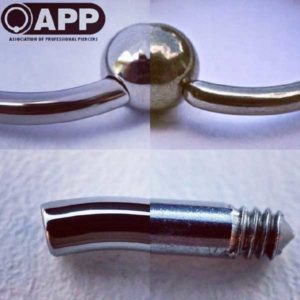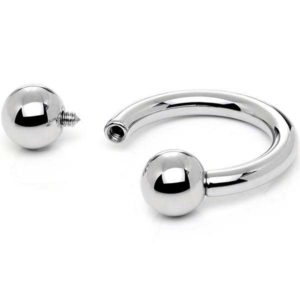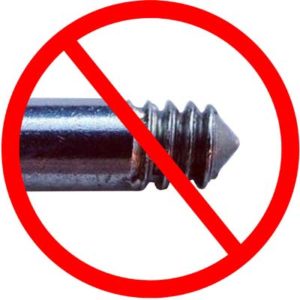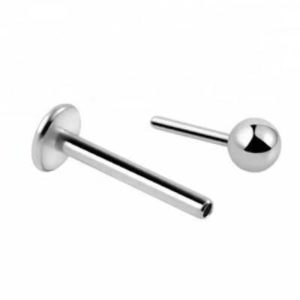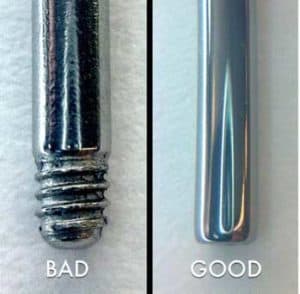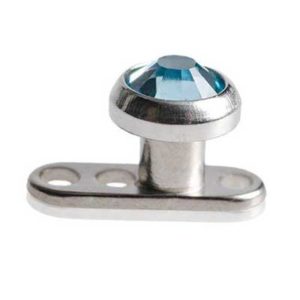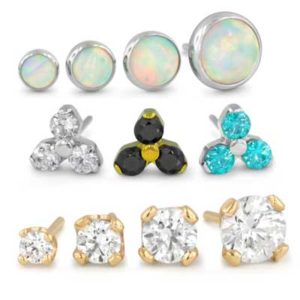Only second to a properly placed piercing, jewelry style and material can drastically increase or decrease the successfulness of your new piercing.
There’s a lot of information to read on the internet these days and unfortunately it is hard to discern the good from the bad. The head piercers at Soular Tattoo and Piercings have many years of experience along with continued education through the Association of Professional Piercers Conferences in Las Vegas (safepiercing.org) which is the industry standard for the newest and highest standard of training and education dealing with our industry.
Through this education and experience we have established a good understanding of what is acceptable to use in fresh piercings. At the root of why we choose to use the highest quality jewelry is the safety and well-being of our clients. No matter how well a piercing is done, metal allergies from cheap stainless steel, micro tears from externally threaded jewelry, and irritation from ill-fitting jewelry amongst other things can cause a piercing to fail. It’s our commitment to our clients that we do everything we can to ensure a successful piercing experience.
In this article we go over some of the aspects of what makes jewelry safe or not. Please take a moment to go over the varying aspects of the jewelry that is available so you may make and educated decision when it’s comes to where you get pierced. Choosing jewelry for a new piercing is obviously quite different from shopping for a ring to wear on your finger. Because body jewelry is worn inside a wound and is in contact with your internal tissues, only certain products are suitable. The look of the jewelry that is placed in your fresh piercing must be secondary to aspects that affect safety and compatibility with your body. The size, style, material, and quality of the initial piece of jewelry all affect your ability to heal. Remember that the piercing location is fixed, but the jewelry can be changed after you have successfully healed. Because the body jewelry industry is saturated with substandard products, piercers and clients alike may forget that cost alone should never be the key factor in your purchase. Consider the following when selecting body jewelry for a new piercing:
JEWELRY SIZE AND STYLE
- Must be of appropriate length or diameter for your unique anatomy and the placement of the piercing. Jewelry that is too tight does not allow for air and blood circulation or for the expulsion of normal secretions from the piercing. Ill-fitting jewelry increases the likelihood of swelling, embedding, and other complications if too small, or catching and excessive trauma, if too large.
- Must be of an appropriate gauge (thickness). The body may treat jewelry that is too thin in gauge like a splinter, resulting in migration or rejection.
- Must be of a style suited to your build and the location of the piercing. Labret studs are best for some areas, straight or curved bars for others, or rings for specific placements.
JEWELRY MATERIALS
Of the numerous materials available, few have been proven appropriate for wear in fresh body piercings. Some metal alloys (mixtures) have been approved based on medical usage (often as medical implants) and have specific designations that represent a precise standard for the alloy and its quality as determined by the American (now International) Society for Testing and Materials Standard (ASTM) and/ or the International Standards Organization (ISO). Other materials, such as gold and obsidian (natural glass) have a long history of use in piercings dating back hundreds—and sometimes thousands—of years.
The material worn in a healing piercing:
- Should be able to withstand the heat and pressure of autoclave sterilization.
- Should be inert and compatible with the body so it doesn’t cause irritation, allergy, or infection.
Mill test certificates (or “mill certs”) are documents that provide evidence of a specific grade of metal with an ASTM or ISO code designation. These are provided to jewelry makers by the manufacturers of the raw materials. Some jewelry companies also have biocompatibility testing done by independent labs. Your piercer may have copies of these certificates available for you to review. You don’t need to understand what the numbers mean, but the document should warrant that the metal is one of the grades listed below. It is not possible to know whether the piece of jewelry you’re buying is from the batch indicated on the paper, but the
presence of documentation listing the appropriate materials means that your piercer is more likely to be purchasing from reputable sources and is conscientious about their jewelry quality.
- Surgical Steel is made of a variety of alloys. Many of them are used for body jewelry, but only a few specific grades are proven biocompatible: steel that is 316lvm ASTM F-138 compliant or ISO 5832-1 compliant; ISO 10993-(6,10, or 11) compliant; or (EEC [European] Nickel Directive compliant. Unfortunately lots of piercing shops still offer and use the subpar 316l steel because of the low price and high return when selling to clients. Prices as cheap as $.25 for a barbell can turn into a $20 retail sale. That’s an 80x markup. Beware of cheap steel as it is sign your piercer cares more about making a maximum profit rather than your well-being.
- Titanium is a lightweight metal that is ideal for people with concerns about nickel sensitivity. This material can be anodized to create jewelry of different colors without affecting the safety. Look for implant certified titanium (Ti6Al4V ELI) that is ASTM F-136 compliant or ISO 5832-3 compliant, or commercially pure titanium that is ASTM F-67 compliant.
- Niobium has been widely used by piercers with good results for many years. It is very similar to titanium, but does not have an implant-grade designation. Like titanium, niobium can be anodized to produce different colors. (And, unlike titanium, it can be anodized black.) Anodized niobium and titanium may fade due to body chemistry or when worn in friction-prone areas, but this is not harmful.
- Gold (yellow or white) is appropriate for initial piercings if it is 14k or higher, nickel free, and alloyed for biocompatibility. Gold higher than 18k is too soft for body jewelry because it can easily be scratched or nicked. Gold plated, gold-filled, or gold overlay/ vermeil jewelry is not acceptable for fresh piercings. All of these involve coating a base metal with a layer of gold. The gold surface (which is very thin—measured in millionths of an inch) can wear or chip off.
- Platinum is a heavy precious metal that is extremely inert and excellent for wear in body piercings. However, body jewelry in this material is rare and very expensive due to the high cost of the material and greater difficulty in manufacturing jewelry from it.
- BiocomPatible Polymers (plastics) including Tygon® Medical Surgical Tubing S-50HL or S-54HL, PTFE (Teflon®), or BioplastTM are considered suitable for new piercings. Tygon is a bio-compatible medical tubing that is highly flexible. It should be changed every few months as it stiffens and discolors from extended wear. PTFE, a white plastic, is widely accepted within the industry. Bioplast was created specifically for piercings and is similar to PTFE, but comes in an array of colors and shapes. These may be worn as a substitute for metal jewelry. With new polymer products coming into the marketplace, check that the product you are purchasing, if not listed above, is USP VI compliant. These can be sterilized in an autoclave.
- Glass—Fused quartz glass, lead-free borosilicate, and lead-free soda-lime glass are inert and considered safe for initial piercings. They can also be sterilized in an autoclave.
JEWELRY QUALITY
scratches, burrs, and polishing compounds. Suitable pieces have no
irregular surfaces that could endanger the delicate healing tissue of a
fresh piercing. Metal body jewelry should be polished to a smooth,
mirror finish. If you wear jewelry that has a porous or uneven surface,
the new cells that form during healing grow into the irregularities.
Then, when the jewelry shifts or moves, these areas tear. As this cycle
is repeated, scar tissue forms and healing is delayed. A faulty finish
can also introduce bacteria into the wound and cause infection.- Quality rings are annealed, which is a heat treatment that makes the metal more
pliable. When rings can be opened or closed without the use of pliers it reduces the risk
of damaging the metal. For thicker rings (especially in smaller diameters) the use of
tools may be necessary. Tools should have brass jaws or be covered with tape or gauze
to protect the jewelry from damage.
THREADING
Threaded jewelry uses tiny screw threads for their closures. One side has male screw
threads that fit into a female hole that is tapped (drilled out) with the matching thread pattern
on the other. One or both ends unscrew.
<Threadless (or “press-fit”) jewelry is an acceptable alternative that uses a pin coupling on the ornamental end, and there are no screw threads at all. Soular Tattoos opt to use this style of jewelry for most initial piercings because of its easy of insertion and wide range of options for ends.
< Threadless (or “press-fit”) jewelry is an acceptable alternative that
uses a pin coupling on the ornamental end, and there are no screw
threads at all. Soular Tattoos opt to use this style of jewelry for most
initial piercings because of its easy of insertion and wide range of
options for ends.
result in the closure of your piercing. Threaded ends should be checked
for tightness daily with clean hands. If they come loose often, you may
have a defective piece. See your piercer for options or a replacement
part. If the ball on your captive ring comes off or is loose, you may need a
new ball, or to have the tension on the ring adjusted. Jewelry should fit
together well. Threaded attachments should fit completely onto posts
without gaps. Threads on screw- on ends and dimples on captive pieces
should be centered for a proper fit.
< Not all piercings have an entrance and an exit. Surface Anchors are very
common now and the jewelry sits below the surface of the skin from a
single point. The threaded top may be changed. Removing the base of the
jewelry causes the loss of the piercing, so this is not normally done. See
your piercer for assistance if the piece shifts or migrates.
< Gemstone settings must be of high quality; stones should be set
securely into the metal, often in a prong or bezel setting. Some
manufacturers use adhesives to attach the gem. If the stone falls out,
which is common with lower-priced goods, the entire piece of jewelry will
need to be replaced as the hole left by the missing gem can harbor
bacteria and increase risk of infection.
Hopefully this article has shed some light on the difference and importance of choosing quality
jewelry and a reputable shop to get your piercing. We know that it costs more to have good
jewelry but it will be INSIDE your body for the remainder of the piercings life. Wouldn’t you want
to best material inserted if you broke a bone? It’s the same for your piercing, love your body
and treat it well! If you would like to continue reading on this subject, here are a few articles
from Brian Skellie from the APP. One of the most knowledgeable and respected piercers in our
industry.
https://brnskll.com/shares/biofilm-external/
https://brnskll.com/shares/f136-13/#more-2559
Thank you for reading and we hope to see you soon to get a beautiful new adornment!

